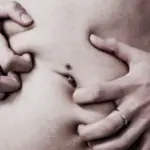
Anorexia has become a very common disorder in the last fifty years, especially due to the imposition of the female beauty canon, characterized by the model of extreme thinness in women.
As this eating disorder has increased, there have been more and more cases in which the patient not only manifests this disorder, but also suffers from some type of additional psychiatric problem.
We’ll see now the main comorbidities of anorexia along with the treatment routes that are usually used for this type of combined disorders.
Comorbidities of anorexia
Anorexia nervosa is an eating disorder. In this disorder, the patient has a body mass index (BMI) significantly lower than that expected in a person of the same height and age, usually less than 85% of the expected weight. This low body size is due to the intense fear of gaining weight, which is accompanied by food rejection behaviors
Comorbidity is understood as the presence of two or more psychiatric disorders or medical ailments, not necessarily related, occurring in the same patient. Knowing the comorbidity of two disorders, in this case anorexia and another, be it anxiety, mood or personality disorder, allows us to explain the appearance of both in the same patient, in addition to providing appropriate information to professionals. and proceed to carry out evaluations and therapeutic decisions.
1. Bipolar disorder
Comorbidity between eating disorders and bipolar disorder has been investigated. The reason why psychiatric research is increasingly focusing on this line of study is that EDs are more common in the bipolar population, which requires designing a specific treatment for patients who have both diagnoses
It is important to adjust the treatment in such a way that the error is not made, when trying to improve the prognosis of, for example, a case of bipolar disorder, as a side effect the course of the ED is harmed.
The emotional lability of anorexic patients can be confused with symptoms of bipolar disorder. It should be noted that the main problem in patients who meet criteria to be diagnosed with both disorders is the patient’s concern about one of the side effects of medication for bipolar disorder, usually lithium and atypical antipsychotics, which can cause weight gain.
This comorbidity is especially striking in the case of patients who are in a state of malnutrition and the depressive episode of bipolar disorder. The symptoms of depression can be confused with the lack of energy and absence of libido typical of anorexic patients recently started in treatment.
2. Depression
One of the main problems when treating depression in patients with eating disorders, and especially with cases of anorexia nervosa, is carrying out an accurate diagnosis. Given the Patients with anorexia usually present malnutrition and lack of energy, it may be the case that depression is camouflaged among the symptoms of starvation. Many patients will recognize that their mood is not normal and will describe them as ‘depressed’, but it does not necessarily have to be that way.
That is why the patient’s progress must be rigorously followed once she is under treatment to gain weight and have normal nutrient levels in the blood. Malnutrition and depression share very striking symptoms such as loss of libido and sleep disturbances. For this reason, once the person is no longer malnourished, if these symptoms are still observed, it is possible to diagnose depression.
Once the person with anorexia nervosa has been identified with a diagnosis of depression, psychotherapeutic and pharmacological treatment is usually followed. In these cases, Any antidepressant is acceptable, except bupropion The reason for this is that it can cause epileptic seizures in those who binge eat and subsequently purge. Although these symptoms are typical of bulimia nervosa, it should be noted that evolving from one eating disorder to another is relatively common.
The dosage of antidepressants in patients with anorexia nervosa is something that must be monitored, given that, Since they are not of normal weight, there is a risk that, by prescribing a normal dose, a case of overdose may occur In the case of fluoxetine, citalopram and paroxetine, it is usually started at 20 mg/day, while venlafaxine at 75 mg/day and sertraline at 100 mg/day.
Whatever type of antidepressant is prescribed, professionals make sure the patient understands that if they do not gain weight, the benefit of antidepressants will be limited. In people who have reached a healthy weight, the consumption of this type of drug is expected to imply about a 25% improvement in mood. In any case, professionals, to ensure that this is not a false positive for depression, ensure that 6 weeks of improvement in eating habits pass before pharmacologically addressing depression.
It is worth not forgetting psychological therapy, especially cognitive-behavioral therapies, given that most treatments for eating disorders, especially anorexia and bulimia, involve working on the cognitive component behind the body distortions present in these disorders. However, it is necessary to highlight that very low weight patients are too malnourished for their participation in this type of therapy to be of any benefit in the short term.
3. Obsessive-compulsive disorder (OCD)
There are two main factors to take into account regarding obsessive-compulsive disorder (OCD) combined with ED.
First of all, rituals related to food, which can hinder the diagnosis and can be seen as more related to anorexia than to OCD itself. Additionally, the person may engage in excessive exercise or obsessive behaviors such as repetitive weighing.
The second factor is the type of personality common in patients of both disorders, with perfectionistic traits, aspects of personality that persist even once normal weight has been achieved. It should be noted that having rigid and persistent personality characteristics, which remain beyond the advanced stages of therapy, are not a clear indication that one is dealing with a person with OCD.
Pharmacological treatment usually begins with antidepressants, such as fluoxetine, paroxetine or citalopram. As an additional strategy, there is the incorporation of small doses of antipsychotics, since there are experts who believe that this contributes to a greater and faster therapeutic response than if antidepressants alone are administered.
4. Panic disorder
The symptoms of panic disorder, with or without agoraphobia, are problematic in a patient with an eating disorder as much as in any other.
The most common treatment of choice is a combination of antidepressants s along with the already traditional cognitive therapy. Once treatment has started, the first symptoms of improvement are observed after six weeks.
5. Specific phobias
Specific phobias are not common in patients with ED, leaving aside fears related to the disorder itself, such as the phobia of gaining weight or of specific foods, especially rich in fats and carbohydrates These types of fears are treated along with anorexia, since they are symptoms of it. It makes no sense to treat the patient’s body distortion or aversion to dishes such as pizza or ice cream without taking into account her nutritional status or working on anorexia as a whole.
It is for this reason that it is considered that, leaving aside body and food phobias, specific phobias are equally common in the anorexic population as in the general population.
6. Post-Traumatic Stress Disorder (PTSD)
PTSD has been viewed as an anxiety disorder highly comorbid with disturbed eating behavior. It has been seen that, The more severe the eating disorder, the more likely it is that PTSD will occur and be more severe, seeing a link between both psychiatric conditions. In developed countries, where people have lived in peace for decades, most cases of PTSD are associated with physical and sexual abuse. It has been seen that about 50% of people with anorexia nervosa would meet criteria for the diagnosis of PTSD, the cause being mostly childhood abuse.
In any case, there is much controversy between having been a victim of traumatic events and its effect on other comorbid diagnoses. Individuals who have suffered prolonged sexual abuse tend to present mood alterations, unstable romantic/sexual relationships and self-harming behaviors, behaviors which are symptoms associated with borderline personality disorder (BPD). This is where the possibility of a triple comorbidity arises: ED, PTSD and BPD.
The pharmacological route is complex for this type of comorbidity. It is common for the patient to present severe mood changes, high intensity and phobic behaviors, which would suggest the use of an antidepressant and benzodiazepine. The problem is that it has been seen that this is not a good option because, although the patient will see their anxiety reduced, there is a risk that they will end up overdosing, especially if the patient has obtained the drugs from multiple professionals. This can lead to a crisis as an adverse effect.
In this type of case, it is necessary to explain to the patient that it is difficult to completely treat anxiety through pharmacological means, which allows for a symptomatic but not total reduction of PTSD. It should be noted that some authors consider the use of atypical antipsychotics at low doses to be more appropriate instead of benzodiazepines, given that patients do not tend to escalate their dose.
7. Substance abuse
Substance abuse is an area that is difficult to study in terms of its comorbidity with other disorders, given that symptoms can be mixed. It is estimated that about 17% of anorexic people manifest alcohol abuse or dependence throughout their lives It should be noted that, although there is enough data regarding alcoholism and EDs, it is not so clear what the rates of drug abuse are, especially benzodiazepines, in the anorexic population.
Cases of anorexia combined with substance abuse are especially delicate. When one of these is detected, it becomes necessary, before applying any pharmacological treatment, to admit them to rehabilitation to try to overcome their addiction. Alcohol consumption in anorexic people with a very low BMI complicates any pharmacological treatment.








